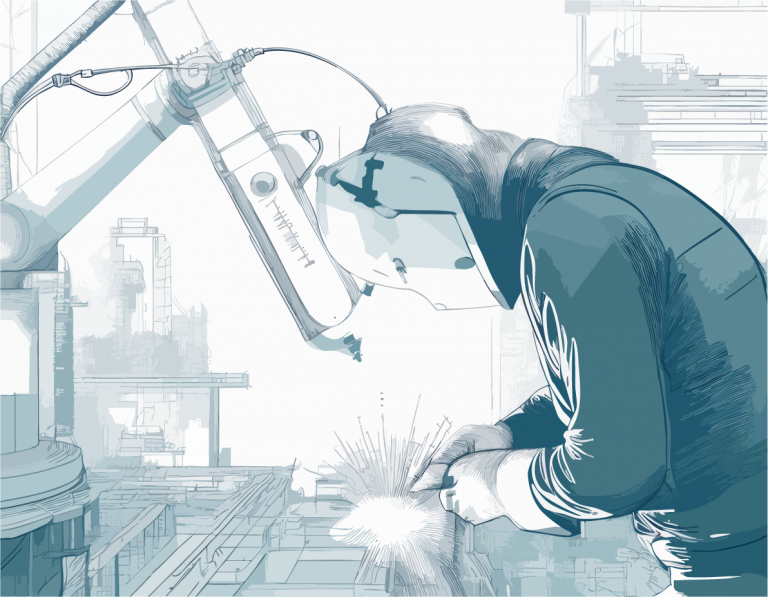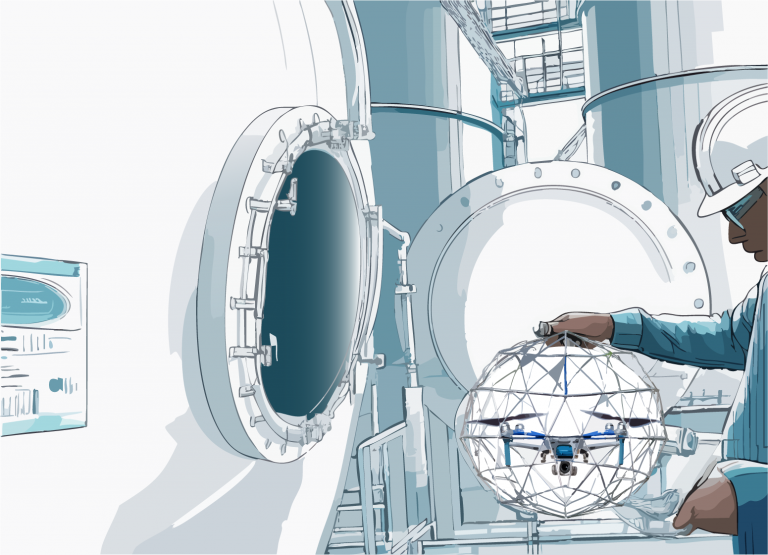The industrial technology landscape is experiencing a paradox. Despite remarkable advances in robotics capabilities and clear safety benefits, adoption rates remain stubbornly low across oil, gas, and power sectors. Our research with asset owners across these industries reveals a fundamental disconnect: the problem isn’t technological readiness but rather the financial frameworks that govern technology investments.
At 8scale, we’ve analyzed spending patterns across multiple industrial sectors and identified a critical barrier to innovation: the artificial divide between capital expenditures (CapEx) and operational expenditures (OpEx). This traditional financial model, while effective in the industrial age, has become increasingly problematic in today’s technology-driven environment. This post examines how current spending models create structural barriers to robotics adoption and offers practical approaches for forward-thinking asset owners to overcome these challenges.
The Self-Sabotage Paradox in Heavy Industry
Our analysis of capital allocation practices across oil, gas, and power sectors reveals a systematic pattern where asset owners inadvertently undermine their own future competitiveness. The data tells a compelling story: in 2024, the oil and gas industry distributed nearly US213 billion in dividends and US136 billion in buybacks, while simultaneously reporting that robotics implementation costs were prohibitively expensive.
This contradiction is particularly striking when we consider the power sector’s investment outlook. According to Deloitte’s 2025 analysis, the US power sector requires US$1.4 trillion in investments by 2030 to meet rising electricity demands, yet continues to underinvest in automation technologies that could dramatically reduce long-term operational costs.
Through our work with asset owners, we’ve observed this self-sabotage pattern repeatedly. During a recent engagement with a Gulf Coast refinery, we witnessed maintenance teams struggling with inspection tasks in confined spaces that had already caused safety incidents, despite the availability of robotics solutions perfectly suited for these scenarios. The procurement team had rejected these technologies six months earlier as “too expensive” relative to their annual maintenance budget.
The Structural CapEx vs OpEx Conflict
At the heart of this adoption challenge lies the fundamental misalignment between traditional spending models and the investment profile of advanced robotics technologies. Traditional heavy industry operates on a principle that made sense in the industrial age: minimize upfront capital costs, then manage ongoing operational expenses through incremental improvements.
Today’s robotics solutions invert this equation. They require substantial upfront investment (high CapEx) but deliver dramatic reductions in ongoing operational costs (low OpEx). As industry experts have noted, this creates “high CapEx and low OpEx that make automation expensive to start, but valuable with high utilization.”
The market data supports this reality. According to Market.us research, the global oil and gas robotics market is projected to grow from US1.9 billion in 2024 US6.0 billion by 2034, a 12.1% annual growth rate that signals the undeniable value proposition. Yet adoption remains sluggish because current spending models simply aren’t designed to evaluate and capture this value.
The 10X Efficiency Trap for Service Providers
Perhaps the most perverse aspect of this misalignment appears in the service provider ecosystem. When service companies bill by the hour, as most do in heavy industry, a 10X efficiency improvement through robotics means a 90% revenue reduction. This creates a fundamental business model conflict that has nothing to do with technological limitations and everything to do with financial incentives.
Consider pipeline inspection as an example. Traditional methods require teams of technicians working for weeks at significant expense and safety risk. Advanced robotics can complete the same task in days with higher accuracy and zero human risk exposure. Yet service providers have little incentive to cannibalize their own revenue streams by adopting these technologies, while asset owners remain fixated on avoiding the upfront capital cost rather than capturing the lifetime operational savings.
The result is a technology deployment rate that lags far behind technological capability, creating an ever-widening gap between what’s possible and what’s implemented.
Regulatory Handcuffs in the Power Sector
The power industry faces an additional layer of complexity through its regulatory structure. Most investor-owned utilities operate under a “cost-of-service” regulatory model that allows them to earn guaranteed returns on capital investments deemed prudent by regulators.
This creates a perverse incentive to “overinvest in capital-intensive projects…and underinvest in less capital-intensive alternatives,” according to Deloitte’s 2025 analysis. Even when operational technologies like advanced robotics could meet customer needs at lower overall cost, the regulatory structure incentivizes utilities to choose more capital-intensive solutions that generate higher returns.
Some regulators are exploring performance-based regulation (PBR) models that reward utilities based on outcomes rather than capital deployed. However, the transition remains slow and inconsistent across jurisdictions, creating a patchwork of incentives that further complicates technology adoption decisions.
The False Economy of Capital Discipline
Our analysis of industry financial data reveals that the obsession with capital discipline while understandable given historical boom-bust cycles has created a false economy where avoiding 10 million in upfront robotics investment leads to forgoing 100 million in lifetime operational savings.
This focus on short-term capital metrics is particularly evident in the oil and gas sector, where companies have increased capital expenditures by 53% while net profit has risen by only 16%, according to Deloitte’s 2025 Oil and Gas Industry Outlook. This indicates a strong preference for controlled spending and immediate returns over transformative investments with longer payback periods.
The Dallas Federal Reserve notes that companies “maintain a conservative stance toward production growth, with continued focus on capital discipline and maintenance capex,” prioritizing existing infrastructure over transformative investments. While this approach may please shareholders in the short term, it creates a dangerous innovation deficit that will become increasingly difficult to overcome.
Breaking the Pattern: Emerging Solutions
Despite these structural challenges, we’re seeing innovative approaches emerge that bridge the gap between traditional spending patterns and advanced technology requirements:
1. Robotics-as-a-Service (RaaS)
New business models are converting the high upfront capital cost of robotics into a predictable operational expense. By paying for outcomes rather than equipment, asset owners can adopt advanced technologies without disrupting their capital allocation models. This approach is gaining traction particularly in inspection and maintenance applications.
2. Strategic Technology Partnerships
Forward-thinking companies are developing strategic partnerships with technology providers, negotiating multi-project agreements that ensure technical standardization and unlock cross-project synergies. This approach distributes the capital burden while maximizing operational benefits.
3. Should-Cost Methodology
Innovative procurement approaches like “should-cost methodology”, borrowed from the automotive industry, are helping companies develop a more sophisticated understanding of the true value of technology investments beyond simple capital metrics. McKinsey’s 2024 analysis highlights how this approach is helping reduce time and optimize overall project spending across the oil and gas industry.
4. Performance-Based Regulation
Regulators are increasingly exploring models that reward utilities based on performance outcomes rather than capital deployed, creating better alignment between regulatory incentives and technological innovation. These approaches focus on creativity, innovation, and balance to develop adequate metrics that reward utilities for achievements without over- or undercompensating them.
5. Digital Transformation Integration
Leading companies are integrating robotics deployment into broader digital transformation initiatives, creating a more holistic approach to technology adoption that better captures cross-functional benefits. This integration helps justify investments by demonstrating value across multiple operational dimensions.
The Path Forward for Asset Owners
For asset owners serious about capturing the benefits of robotics and advanced technologies, we recommend five key actions:
1.Evaluate technology investments based on total lifetime value, not just upfront capital cost or quarterly budget impact
2.Develop new procurement frameworks that can effectively assess and capture the value of high-CapEx, low-OpEx technologies
3.Create internal financial mechanisms to bridge the gap between capital and operational budgets, enabling more flexible technology adoption
4.Partner with service providers to develop shared-value models that align incentives around efficiency and outcomes rather than billable hours
5.Engage proactively with regulators to develop more innovation-friendly frameworks that reward performance over capital deployment
Conclusion
As industrial technology continues to evolve, the companies that succeed won’t necessarily be those with the most advanced technical capabilities, but those who effectively bridge the gap between innovation and financial frameworks. By rethinking traditional spending models, developing more sophisticated evaluation approaches, and creating alignment between stakeholders, asset owners can unlock the transformative potential of robotics and other advanced technologies.
At 8scale, we help industrial companies navigate these complex transitions by providing evidence-based analysis of technology value propositions, developing implementation roadmaps that align with financial realities, and facilitating partnerships that create shared value across the ecosystem. The robotics revolution isn’t waiting for permission, it’s simply waiting for financial models to catch up with technological reality.
Ready to transform your approach to technology investment?
Download our complete guide to evaluating robotics ROI or schedule a consultation with our technology intelligence experts to discuss your specific challenges.





